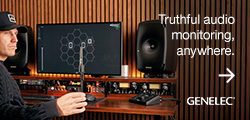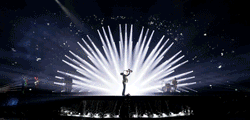![]() Flare Audio is relatively new to the loudspeaker market, but the company promises to bring with it a sea change in our understanding of loudspeaker physics and possibly set a new benchmark in loudspeaker performance.
Flare Audio is relatively new to the loudspeaker market, but the company promises to bring with it a sea change in our understanding of loudspeaker physics and possibly set a new benchmark in loudspeaker performance.
With a background in applied physics, founder Davies Roberts’ ideas on fixing the ills of loudspeaker enclosure have evolved into a range of products that covers large-scale line-array components to close-field studio monitors.
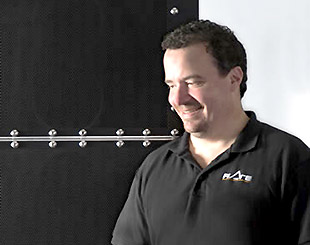 My introduction to Flare Audio was in an enormous field in the grounds of Hatfield House, Hertfordshire where the Flare Audio team were putting the theory to the test. The results were stunning. I had to move a long way away from the sizeable test array to get any real audible sense of distance, the rear attenuation was enough to make me wonder if someone was turning the system down every time I walked behind the array, and the fidelity was excellent. Of course, with virtually no stage, no walls, and no audience, the test was controlled, but impressive none-the-less.
My introduction to Flare Audio was in an enormous field in the grounds of Hatfield House, Hertfordshire where the Flare Audio team were putting the theory to the test. The results were stunning. I had to move a long way away from the sizeable test array to get any real audible sense of distance, the rear attenuation was enough to make me wonder if someone was turning the system down every time I walked behind the array, and the fidelity was excellent. Of course, with virtually no stage, no walls, and no audience, the test was controlled, but impressive none-the-less.
If Cybermen made loudspeakers, they would absolutely look like this. Most obviously, they are shiny and seem to have way too many screws in. Of course, many of us have a tendency to overdo fixings, especially now that electric screwdrivers often come with spare batteries, but in the case of Flare, these features really are ‘proper’ features. Also, I think they can also come in black, if that’s what you want.
The front and rear plates on the Flare full-range products are solid, high-grade aluminium. Between these plates is a wood structure that hides the Vortex porting technology inside. The large M8 bolts that emerge front and rear of the enclosures are there to exert an evenly distributed, high mechanical compression force on this structure, squeezing the wooden structure and forcing it into a highly stable, solid state. This is Flare’s ‘Space’ technology – eliminating resonances from the central structure with obvious benefits to the sandwiched components, which can then operate closer to their theoretical limits.
Roberts told me that, while the number is a trade secret, the pressure involved is ‘significant’, though not unbounded. Flare has developed a test process for checking the correct pressure is applied evenly at manufacture. Too much and you go back into instability. A side benefit of all this engineering and the necessary CNC is that every part of the speaker is replaceable, construction is simplified, and quality control should be a doddle...
Spin Me Right Round
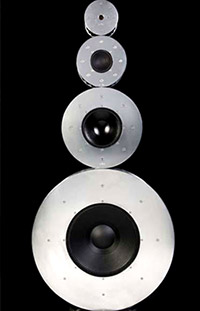 Inside this structure is a bit of closely-guarded geometry that constitutes Vortex ‘porting’ technology. It’s important to stress here that the ‘porting’ does not refer to a reflex port, which is used in many speaker designs to extend bass response by creating a resonance just below the natural cut-off point on the system. Indeed, the whole point of Flare’s Vortex technology is to verge on the ideal infinite baffle, where the front and rear of a driver are separated by, say, an infinitely large, infinitely stiff wall.
Inside this structure is a bit of closely-guarded geometry that constitutes Vortex ‘porting’ technology. It’s important to stress here that the ‘porting’ does not refer to a reflex port, which is used in many speaker designs to extend bass response by creating a resonance just below the natural cut-off point on the system. Indeed, the whole point of Flare’s Vortex technology is to verge on the ideal infinite baffle, where the front and rear of a driver are separated by, say, an infinitely large, infinitely stiff wall.
Traditionally, what many call the ‘closed box’ has been the real-world equivalent of an infinite baffle because the rear of the drivers is wholly enclosed. However, this is a bit of a cheat, especially when considering cabinet resonances and the impedance/friction presented by the air that is trapped. This last limitation, Roberts maintains, is responsible for one of the big problems in loudspeakers, and that is an asymmetry in the driver’s movement. An ideal infinite baffle would present no resistance to the compression (inward) movement of a driver.
The result of this asymmetry in the driver’s movement is a type of distortion that Roberts claims to have eliminated with Vortex technology. That is, the geometry inside the box creates a vortex behind the driver before the air comes out of the rear port. ‘A vortex by its very nature kills amplitude but maintains phase – that’s the description of a vortex, so it allows us to do two things: First, it kills amplitude before it comes out of the port; second, it allows us to speed up the sound in certain ways so that when the driver presses a compression or a vacuum behind the driver, the ports don’t add any friction.’
The result? A driver that is as happy to go in as it is to come out – which has to be a good thing.
Bass
Vortex and Space are the two main new technologies in the Flare Audio full-range monitoring. In the Flare bass cabinets, the approach is slightly different. These products incorporate Flare’s Nanoflow Loading Technology in order to preserve ‘waveform integrity’. Basically, the drivers are aligned in a semi-circular configuration to enable a single coherent sound wave from multiple drivers and multiple boxes.
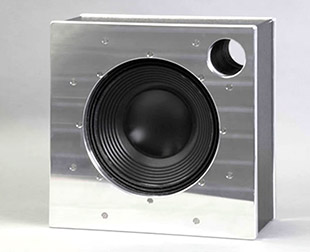
Roberts: ‘A problem with a front-loaded box or with a typical horn-loaded box is the horns all tend to exit on a ninety degree angle and none of them can couple coherently, so when you line them up you tend to have sound causing a lot of destructive and constructive interference. Nanoflow is really an interference reducing technology for the alignment of subs.
‘The drivers are mounted on a baffle in an arc and then any streams come together and exit alongside each other so that when you saw the subs across the front of the stage you effectively have one giant piston moving backwards and forwards.’
A Flare for the Dramatic
As mentioned earlier, one of the really interesting aspects of all this is that the Flare Audio core technologies can be applied to any loudspeaker. Flare already has line array elements, install, and studio products and has plans for more. It already has interest registered for cinema and dubbing theatre installations – timely considering the surge in interest in Dolby Atmos. This includes the ‘Boutique-style cinema’ project at the Olympic Studios redevelopment.
‘We are actually looking into headphones and to into micro-devices too with this technology,’ adds Roberts. ‘...We will be developing not just studio – not just pro, but also home premium – possibly some commercial mass market products too.’
Final Flourish
I you get a chance, listen to a Flare Audio loudspeaker, in whatever guise. It’s quite an experience. I have seen the numbers that came back from the testing session Though my ears told me it was pretty good...
More: www.flareaudio.com
This post first appeared on The Audio Production Network, authored by Paul Mac.






